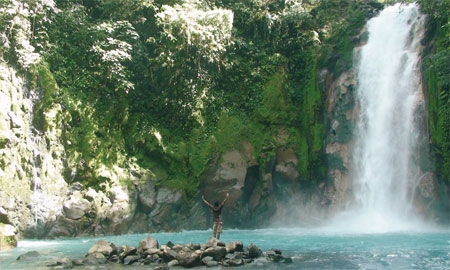Besides being home to Central America’s most literate and longevous population, Costa Rica also boasts the region’s largest middle class, oldest democracy, and most stable economy. And it’s one of the world’s foremost renewable energy leaders, to boot.
“Costa Rica is a country that has always dreamed big. History has proven that despite our small size, and although we are located in a region characterized by conflict, we have surprised the world in various moments of our history,” says Laura Chinchilla, President of Costa Rica.
Sworn in on May 8, 2010, Mrs. Chinchilla served as one of two vice-presidents under Oscar Arias’ (winner of the 1987 Nobel Peace Prize) second administration. Her policies continue in line with his, and she has set definite goals to reach by 2021, the year Costa Rica celebrates its 200th anniversary of independence. These include reaching electricity production from 100% renewable sources and becoming one of the most developed countries in Latin America.
Having officially disbanded the army in 1949, the Costa Rican education and healthcare systems have enjoyed a larger share of the budget, leading to the development of a well-educated and healthy nation. According to the Happy Planet Index 2.0, Costa Rica is also the happiest and greenest country, with the highest life satisfaction, in the world.
The nation’s well-educated workforce coupled with a long history of political stability have contributed greatly to attracting foreign investment, which in turn has triggered steady economic growth. GDP growth averaged 6% in the several years running up to 2009, when it shrank 2% as a result of the global recession. The economy has also undergone a transformation over the past few decades, with the rise of high-tech industries outpacing agriculture – though coffee, pineapples, and bananas still remain powerful contributors to the country’s economic stability.
Another factor of Costa Rica’s business magnetism is its environmental policy, considered by many a definite competitive advantage. The extractive industries are allowed to play only a tiny role in the economy, and the government has been playing this card to attract FDI in more non-polluting and high-earning sectors, such as the production of high-tech equipment and medical components. These are then exported to over 100 countries, thanks in large part to a growing number of free trade agreements.
“We are one of the biggest exporters per capita in Latin America,” says Melvin Saenz Biolley, the Costa Rican ambassador to Nicaragua, “and we have developed a network of commercial treaties that is affording us access to our fundamental partners, as well as to the areas of greatest growth and importance in the international economy.”
Costa Rica’s relations with the United States have long been healthy. Luis Liberman, Second Vice President, states: “This relationship is the most important one we have politically, financially, and commercially… Our relations are friendly and strong.”
Back in the 1980s, when much of Latin America was in political turmoil and the global commodities crisis paralyzed many economies, the U.S. stepped in with the Caribbean Basin Initiative (CBI) – a unilateral trade program that facilitated exports from the region’s countries – and virtually rescued the Costa Rican economy, which at the time was heavily reliant on commodities such as coffee, bananas, and meat. The CBI was a tool that “allowed Costa Rica to transform its economy from an import substitution economy into an export one…helping these countries in general, and Costa Rica in particular, to develop the economy, resolve social problems, and grow and integrate into the world market,” explains Luis Gamboa, president of AmCham in Costa Rica.
The only Latin American country included in the World’s Oldest Democracies list, Costa Rica is grabbing global bullish problems such as climate change by the horns, and facing its own faults head on. The state is promoting more technology-oriented education, stricter policies concerning drug trafficking, and more investment in transportation infrastructure.
All in all, this green oasis of unspoiled beauty, safety, and high productivity awaits investors and tourists alike.

0 COMMENTS